All about the marquises

Awnings are widely used in the construction industry. From the material in this article, you will learn what they are, what advantages and disadvantages they have, what their types are. In addition, we will tell you how to choose them correctly, mount them and make them yourself.

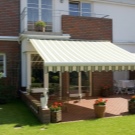


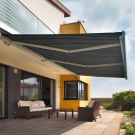
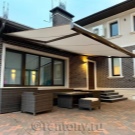
What is it and why are they needed?
The word "marquise" means "fabric canopy from the sun." It consists of a lightweight frame with a polymer coating, a fabric awning (stretching cloth) with a special impregnation, as well as a control mechanism. The canopy can differ in size, shape, and has a lot of varieties. Based on the purpose, it may have a different design.
It is intended for outdoor use, therefore it is made of practical and high quality materials.
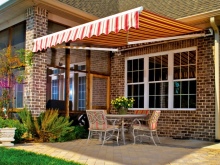

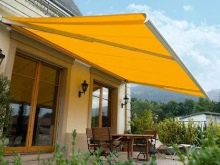
Awnings are mounted on terraces, verandas, facade walls of buildings, windows, balconies. They can be seen in winter gardens, summer cafes, shopping pavilions. They serve several functions, for example:
- shade open areas from ultraviolet rays;
- create comfortable conditions for recreation;
- protect doorways, windows from precipitation;
- decorate the architectural concept of buildings.
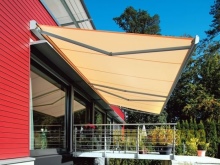
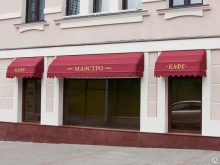

The difference between awnings and ordinary visors is the presence of a folding mechanism, allowing you to push in and out the structure. Awning canopies have a tilt adjustment. Thanks to this, they can shade different areas of the site.
With the help of these structures, space is zoned. For example, they are used to shield outdoor terraces from curious neighbors or people from the street. Less commonly, awnings are used to shade plants in the garden and isolate garden recreation areas.

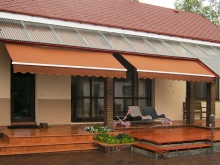
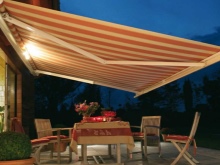
Advantages and disadvantages
Awnings have many advantages. They are versatile, functional and aesthetically pleasing.... Visually ennoble the facade of buildings, increase their respectability. Contribute to the creation of coziness.
They are practical and durable, easy to use and easy to install.... Awning canopies protect the walls of the house from overheating, reduce the temperature inside the premises by several degrees. They do not load bearing walls.
The products are compact and can be assembled for storage in the winter season. The choice of products is very diverse, in the lines of sellers there are options for every taste, color, architectural style.
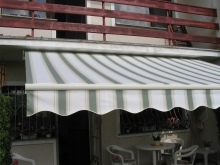


Products do not need specialized supporting elements and fasteners... They are mounted directly on the wall of the structure. Only a small part of the modifications, which are distinguished by impressive dimensions, are mounted separately.
You can install them without the help of professionals, which saves your budget. Sheds can have not only manual but also remote control. They are mobile, easy to transport, unpretentious in maintenance, and have an expressive design.
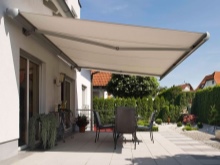
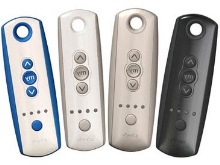

Fits perfectly into the cityscape and natural landscape. They are inert to fire, do not give glare, in most cases they are fixed only on the wall of the facade. Effectively cool the premises, reducing the cost of the air conditioner.
Along with the advantages, the marquis has several disadvantages. Awning coverings are not designed for heavy weight loads. This is what forces them to fold for the winter.
Some structures cannot withstand gusty winds and prolonged showers.However, this problem is solved by special sensors for automatic folding.
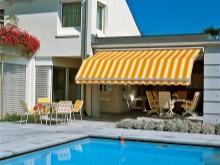

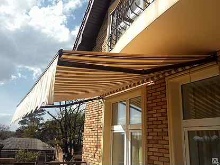
Varieties
All types of outdoor sun protection systems can be classified according to different criteria. Manufacturers produce a wide variety of products. For example, in addition to the usual options, there is a double-sided awning on sale.
In addition to the usual street varieties, today you can purchase models for a winter garden, window and doorways, and a balcony. The material of the awning can be traditional, transparent, dense, classic.
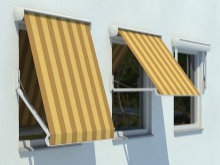
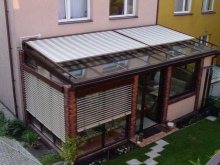
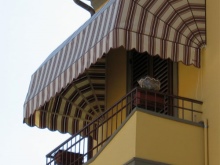
By location
Based on the location, allocate window, balcony, terrace, pergola types of awnings. Based on the scope of application, each type of product has its own differences.
Window options include several lines, these include roll, basket (folding and stationary), front, display modifications. They are small in size, can be straight, spherical, inclined.
Window awnings are often equipped with an automatic drive. This simplifies the operation of the product and makes it convenient.
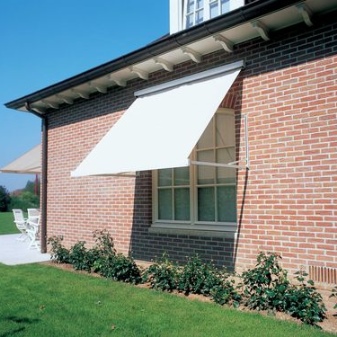
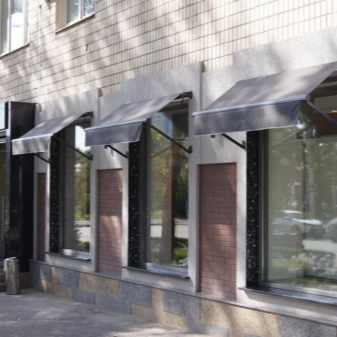
Terraced facade systems are complex. When unfolded, they are held by levers-elbows, due to which they are called elbows.
The principle of operation of the structure is manual and automatic. The assembled elbow awning is stored in a cassette. Thanks to this, it is reliably sheltered from adverse external factors.


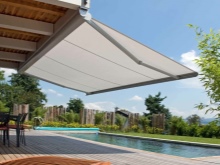
Balcony model when open, it looks like a curved roof with an original visor. The central part of the departure is equipped with a longitudinal beam that regulates the canopy.
Retractable systems can work due to automation, equipped with a special unit that reads the weather thanks to a photocell and other sensors.


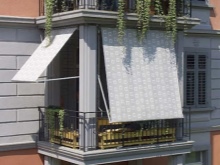
Pergolas are equipped with 2 or more supporting elements. This eliminates the likelihood of deformation of the structure under the influence of gusty winds. The complexity of the execution of the models varies.
Front display options decorate residential buildings, terraces, verandas. They are irreplaceable above the windows under the roof, they can become a decoration of the attic.
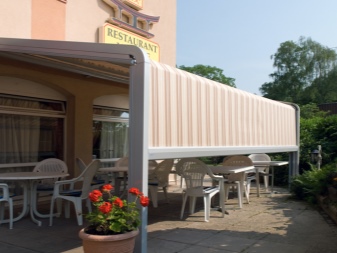

By constructive mechanism
Ready-made awning awnings are classic, folding and sliding, open and closed. Modifications open view the most simple and inexpensive. They are a structure with a shaft on which the web is wound.
They are installed in the presence of a visor or niche that protects the working mechanism. When the awning is installed on an open façade, the system must be semi-closed or closed.
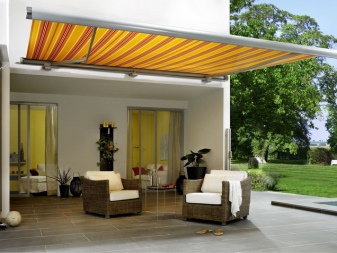
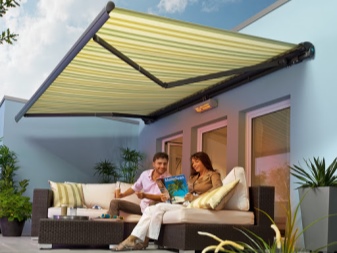
Such varieties are divided into 2 types: semi-cassette and cassette. The first versions have a working shaft and an awning protected by an upper box and a sliding bar. When the awning is assembled, the fabric shaft is partially open at the bottom.
Products closed type equipped with a special housing that protects the opening and closing mechanism from negative external factors. They are more practical, can have a wide variety of designs (wood imitation, chrome texture), lighting, and speakers.
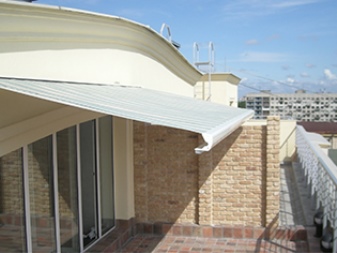
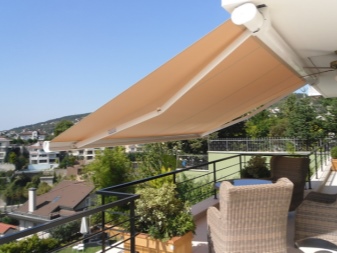
Fastening of structures can be external and internal. Varieties of the first type are attached directly to the facade, the second to the window frame. The control mechanism is mechanical, automatic, remote.
Variants with built-in electronics more durable. They have less wear of the control mechanism, correct opening and closing of the system. Their frame is rarely damaged during operation. In bad weather, the automation independently folds the canvas and puts it into the existing box.
Retractable systems are capable of covering large areas. Therefore, they are used to equip street cafes and trading floors. In the winter season, they are folded. Models can be laconic or decorated with lambrequins.
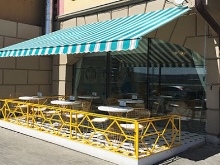
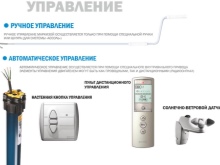
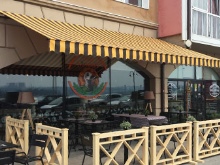
Driving force
The mechanism of the system is lever-roll, with a single axis of rotation and awning. The first type system is equipped with two folding arms that unwind the hanging textiles from the shaft.
The supporting arches of the dome mechanism have one rotational axis. Moreover, their shape, length, height can be different. A cord control mechanism connects all arcs to each other.

Marquisolette - 2-part system... One of them protects the area, the other is needed to create a visor. The ratio of both parts can be adjusted.
The manual type of control is worm and tape. The first is used in lever-roll versions of small sizes, the second - in basket-type devices. Heavy-duty retractable structures are powered by an electric drive.
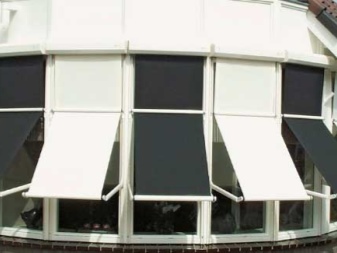

By geometric orientation
The geometry of awning sun-protection systems is horizontal, vertical, lateral... The products of each line have an adjustable tilt height, which adds to their convenience in use.
Horizontal outdoor awnings are popular options for gazebos, terraces, balconies. Outwardly they look like regular elbow models. They have an improved design thanks to the cassette and additional functions.

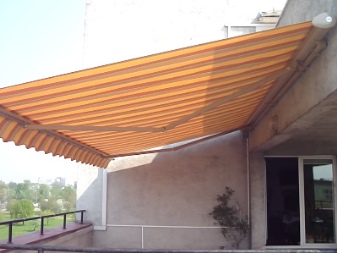
Depending on the type, they are completed classic or retractable lambrequin. The second type is better, it provides additional protection from the sun, gusty winds and precipitation. Products of this type have both horizontal and vertical awning options.
The advantage of the structures is ease of use due to the stepless adjustment of the angular tilt (up to 90 degrees). These systems open not only completely, but also partially.
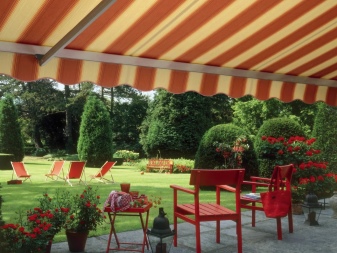
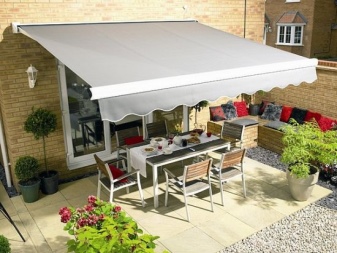
Vertical sun-protection counterparts unfold from top to bottom. Visually, they resemble curtains that ennoble the space, protect it from the sun, rain and wind. Their box is angular and rounded.
They differ from traditional open awnings in that the material is moved not along the ropes, but along the existing guides. Structures with guides are stretched more evenly, their tightness is much better.
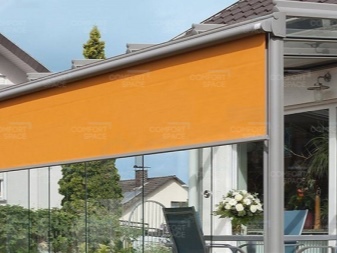
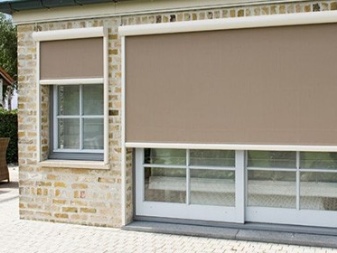
Side the cassette-type canopy model is fixed to the wall, facade, other vertically located surface. If these grounds are not available, it is fixed by means of metal racks.
When closed, the material is wound on a drum and hidden in a cassette. To open the system, pull on the handle located on the side of the profile. Roll the awning is opened by a roller that provides free sliding when opening and closing the awning.
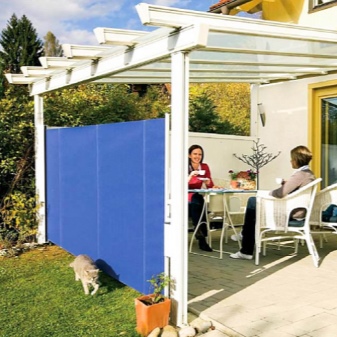
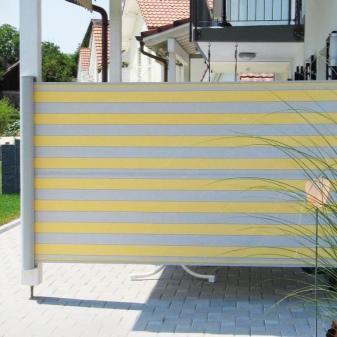
Inclined systems are straight (showcase), basket (dome). Showcase modifications are easy to install and have a quadrangular shape. Fastened horizontally.
Dome (basket) types of structures have a hemispherical shape. They are decorative and aesthetically pleasing. Used in the design of boutiques, restaurants, cafes.
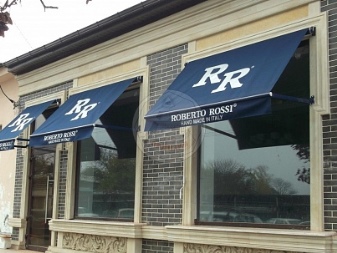
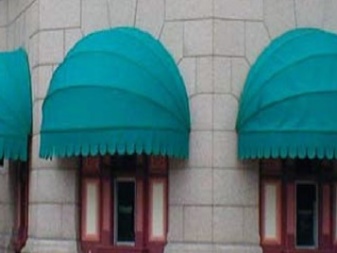
The folding dome awning will favorably emphasize the facade of any building... A fan awning often decorates the doors of shops, restaurants, cafes, windows. It is fixed to the wall by means of brackets and has an unusual appearance.
In addition to modifications of the one-sided type, two-sided models are also produced today. These awnings are designed to shade large areas.


By materials of manufacture
The frame of awning canopies is made of aluminum or stainless steel with a protective coating... Steel varieties increase the weight of the structures.
Awnings are made from three types of raw materials: acrylic, PVC and polyester. Each type of material has its own characteristics.
The acrylic sheet is durable and particularly resistant to fading. Possesses high air permeability, durability, high decorative properties. It can be classic and textured, monochromatic, with a printed print.
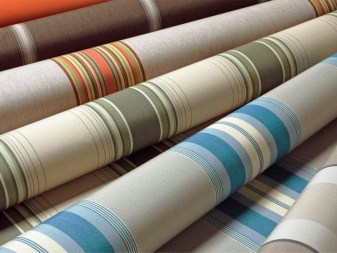
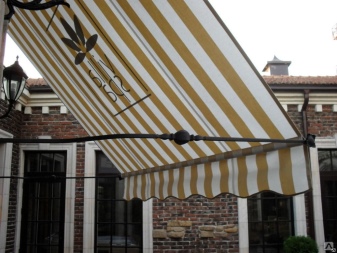
PVC film has a smooth glossy surface. Refers to budget tent materials. Optimally strong, inert to temperature fluctuations.Differs in high elasticity, without load it takes its original shape.
Polyester fabric is not as popular. It is decorative, but not resistant to fading. It is used for seasonal protection of porches, terraces, open verandas and gazebos.
In order to increase the protective properties, awnings are treated with antiseptic, ultraviolet, dirt-repellent impregnations. Teflon coatings repel dust, dirt, scatter UV rays, and prevent creases and folds from forming.
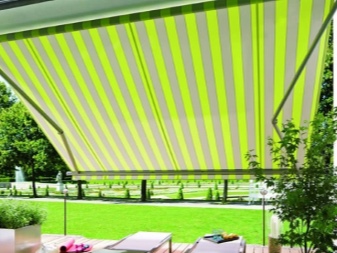
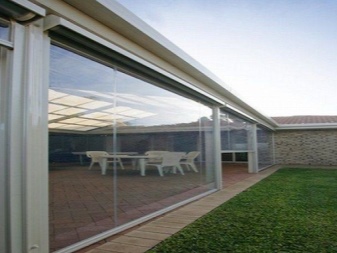
Dimensions (edit)
Product parameters vary. Typical options for windows and doors are awnings with a length of 0.4-1.3 m and a width of 0.15-0.4 m. Buyers often choose models with dimensions of 70x350 cm.
Analogs shading summer cafes and gazebos have different dimensions. Their length can be 2-3 m or more, the width is selected depending on the area that needs to be shaded.
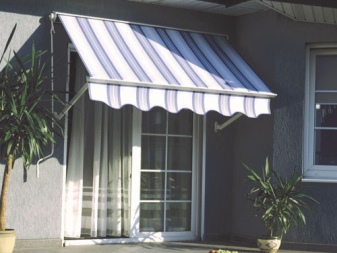
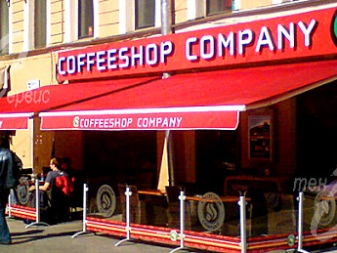
The outreach of the awning can be up to 5 m. The removal of modifications for winter gardens sometimes reaches 6–7 m. The length of individual structures corresponds to the dimensions of window, doorways, balconies.
When using brackets with fasteners on the sides of the window, the extension of the panel corresponds to their length. The maximum size of the awning in length is up to 12-14 m. The carrying out of basket awnings is 70-200 cm.
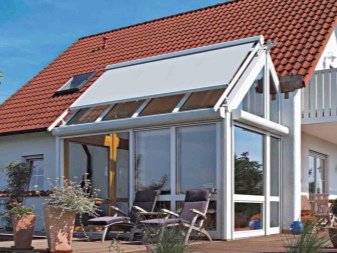
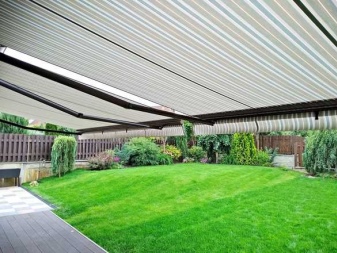
Top manufacturers
Various leading brands are engaged in the production of hinged awnings. For example, quality products are produced by the company Markiza.ru. The trade mark sells awnings of cassette, elbow, vertical types, pergola models with electric and manual control. The products are intended for shading windows, gazebos, terraces, various types of verandas and baths.
Manufacturers have quality modifications Warema and Sportstyle. Trade marks supply to our market frame and awning structures complete with reliable high quality fittings, made according to advanced technologies.
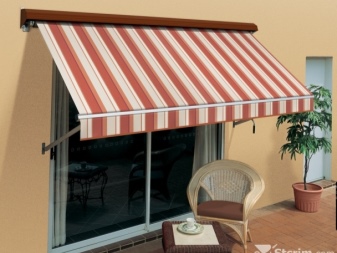
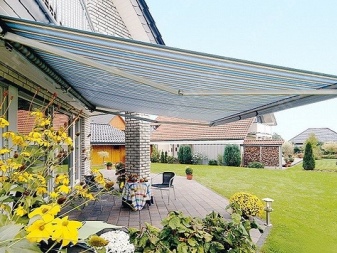
The Warema company sells awning structures not only with acrylic canvas, but also with special Screen and Soltis sunscreens... The first type of textile has a mesh structure. It scatters infrared and UV rays, does not deform, resists fading.
The second tissue has a finely porous structure. It copes well with protecting the shaded area from overheating, has mechanical strength.
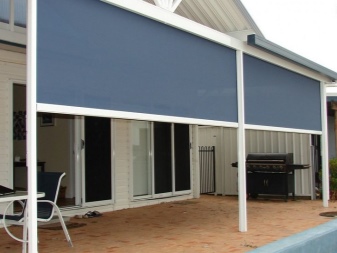
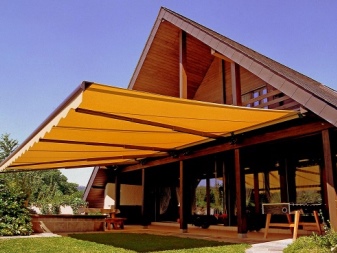
ZIP-tarpaulins of the trade mark are distinguished by rigid fixation of textiles in guides. This allows them to withstand gusty winds. Due to their structure, they can be used as mosquito nets.
French brand has good materials for awnings Dickson Constant. Products of the trade mark serve for more than 10 years, keeping their original aesthetics.
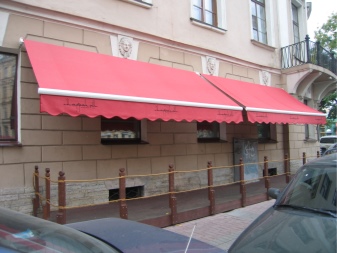

Selection and installation tips
Choosing a certain model of awning for installation in the country or the facade of a country house, you need to take into account a number of criteria. Initially, it is necessary to choose the right awning material. Usually it is an acrylic material with a high margin of safety, resistance to water, moisture, dust, ultraviolet light.
It is important to pay attention to the frame of the product. Aluminum pipes are considered the best material. They are less susceptible to rust than other materials. The mechanism can be either manual or automatic.
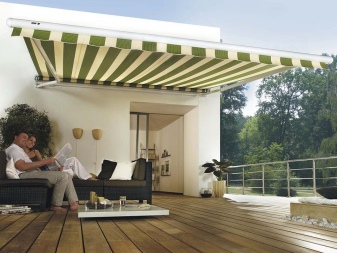
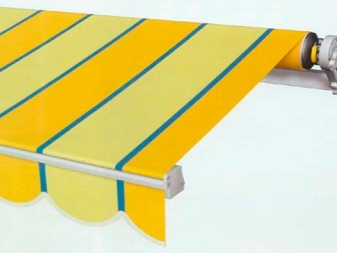
When choosing awnings, they are based on the size of the product, its length, width, type of construction and fasteners. The parameters of the canopy should correspond to the area where you want to create the shadow.
This also takes into account the harmonious combination of the awning with the facade. You need to buy a structure from a trusted supplier that guarantees the quality and reliability of products.
In terms of cost, open systems are cheaper than cassette designs. However, the second options are more reliable.... They practically do not jam when opening and closing due to their protection from outside interference.
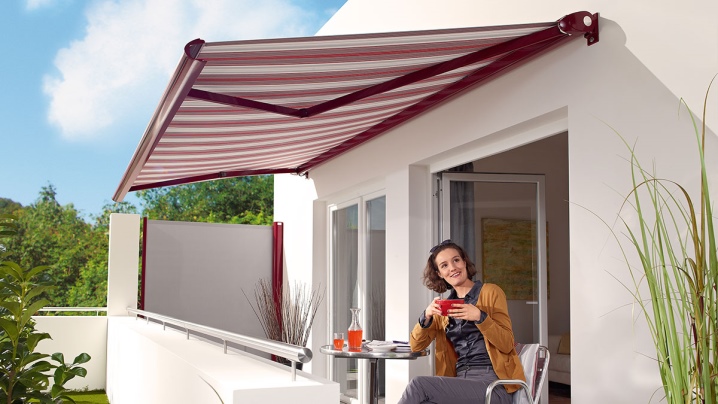
Installation of structures is simple. The sections of the wall for fixing the awning must be reliable and durable.If necessary, they are strengthened using chemical anchors that fill the voids with a special hardening compound.
The type of fastening depends on the facade itself. For example, self-tapping screws are used for a timber building. For masonry walls - studs. If the installation requires through fastening (to the pole), bolts are used. The wall thickness when installing the retractable awning must be at least 150 mm.
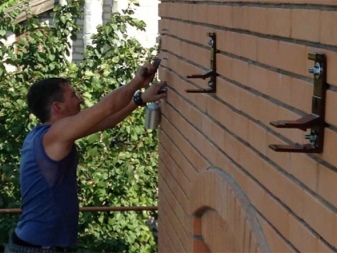
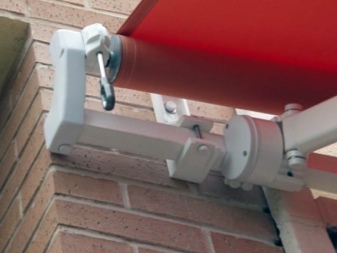
The mounting location is determined taking into account the direction and strength of the wind. Most of the products are equipped with fasteners designed for wind speeds up to 12 m / s.
It is better to assemble and disassemble the system with an assistant. The awnings have quite powerful springs; if handled carelessly, they can cause injury.
To ensure timely drainage of water from the canopy surface, the roof slope angle must be at least 15 degrees.
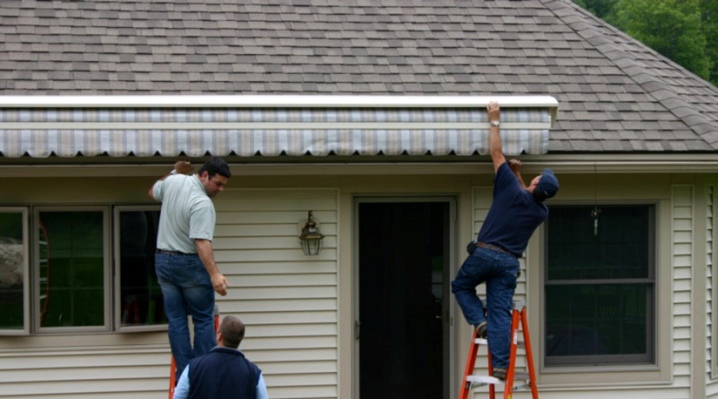
How to do it yourself?
To make your own sun canopy, you must follow the basic steps of the step-by-step instructions.
- Determined with the installation site of the hanging awning, dimensions. A light-colored, non-fading acrylic sheet with a texture you like is prepared. Purchase hollow aluminum or steel tubes and a folding mechanism.
- The working mechanism of the awning is attached to the wall of the house by means of the brackets supplied with the product. If the canvas is included in the package, it is attached to the frame with the opposite side.
- If the canvas is purchased separately, it is attached to the rolling drum on one side, and to the frame on the other.... This can be done according to the instructions that are always attached to the device.
- The frame base consists of U-shaped tubes... It is fixed at the required height on an axial hinge mechanism to the brackets bolted to the wall of the structure.
- The edge of the panel, located opposite the drum, is attached to the frame... When the rolling mechanism is activated, the drum will begin to rotate. The material will be wound around it, after which the folding of the frame will begin.
- The installation of the product is carried out with the maximum possible stretch of matter. During gusty wind or rain, this will prevent the structure from sagging and extend its life.
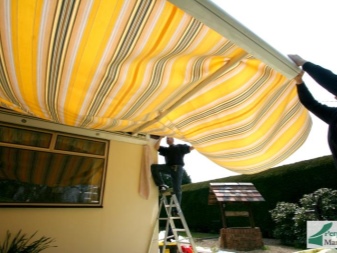
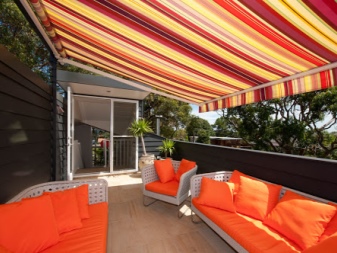
Care features
Care of the awning must be correct and timely... For the winter, it is dismantled or put into a special cover. About 1-2 times a year, the product units are serviced: they change the lubricant, adjust the elements.
If necessary, the cloth is cleaned with a dry brush. If it is necessary to wash the tent, use a soft sponge and soapy water. The use of aggressive chemicals is excluded. Such agents damage the surface of the web.
If the canopy does not have sensors that determine the strength of the wind, the product is rolled up on its own in bad weather. They do the same when leaving home for a long time.
It is unacceptable to hang various objects on the awning that can damage the canvas, cause the structure parts to collapse.
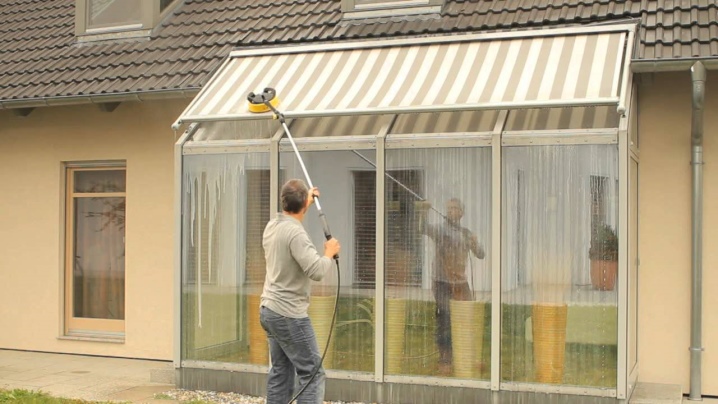





























































The comment was sent successfully.